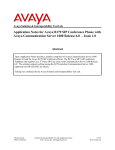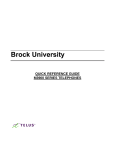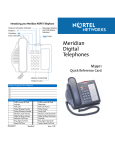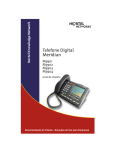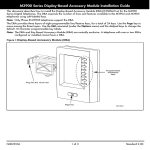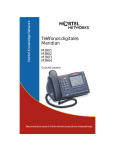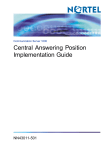Download Avaya B179 User's Manual
Transcript
B179 Release 2.2.1 ReadMe Issue: 1.1 Date: 8 June 2011 This file is the Readme for the Generally Available Avaya SIP conference telephone B179 Release 2.2.1. This file describes the contents of the Release, but since this is the initial release, no comparison is made with earlier releases. OVERVIEW The B179 is a SIP conference telephone, developed by Konftel (wholly owned by Avaya, Inc.), and uses OmniSound® technology to provide full-duplex, crystal-clear sound for all participants. This technology includes noise suppression and equalizer functionality to avoid clipping, minimize background noise, and in general provide a superior conferencing experience. Of course, optimal performance is obtained in environments free of acoustic interference. The B179 is a flexible SIP-based conference phone and is intended for medium-to-large conference rooms or other such environments (e.g. auditoriums) for companies that use IP voice services, and provides standard telephony functionality as well as providing the following enhanced features: • The telephone can interface to Public Address (PA) systems • The B179 is also ideal for larger conferences since it can accommodate expansion microphones • Users can record calls with an SD card that is included as part of the standard package. • Four personal user profiles each hold up to 1000 contacts and 20 conference groups of up to five names. • A wireless headset adapter interface is supported. • PoE (Power over Ethernet) • Web-based configuration Copyright Avaya 2011 All rights reserved 1 INSTALLATION OF B179 RELEASE 2.2.1 The B179 is supported on the following call servers: Call Server Notes CM Release 5.2.1 and later CS1000 6.0 and later IP Office 7.0 and later Other configurations of call servers and circuit boards were not tested and such performance cannot be guaranteed. KNOWN CONSIDERATIONS AND LIMITATIONS OF B179 RELEASE 2.2.1 • The telephone only supports SD cards up to 2GB; SDHC (High Capacity) cards are not supported. The SD card file system has to be FAT 16 (also simply called FAT) or FAT 32. The SD card that is shipped with the telephone is properly formatted. • When calling from 96x0 H.323 to B179. Putting the call on-hold from 96x0 is successful but un-hold of the call causes the call to drop. This only happens if the network region is set for G.729 only. The workaround is to configure G.729 & G.711 in the ip-codec form. • Call initiated from 1140e SIP phone to B179 using G.729. Put the call on-hold from 1140e and B179 displays unsupported media and drops the call. The workaround is to set the codec list of 1140e to PCMU, G.729, G.722. Set codec of B179 to G.722 u-law as 4-high, then G.729 as 3. • Call initiated from M3904 digital set to B179 using G.729. Put the call on-hold from M3904. When the call is taken off hold, there’s no voice path in both directions. The workaround is to set the codec list on B179 to G.729 as 4-high and G.711 ulaw as 3. SIP-TLS is not supported on CS1K. This support is planned for the November 2011 release. • When a CS1000 phone calls the B179, the B179 display shows the calling party name. But when the call is answered, this changes to "sip". • Blind transfers by the B179 fail. CS1K rings transfer-to phone once and then stops. Copyright Avaya 2011 All rights reserved 2


